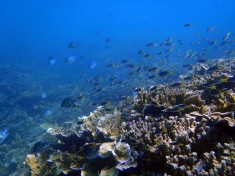Sunscreen Chemical in Soaps, Cosmetics, & Body Fragrances Threaten Coral Reefs, says Haereticus
Industry: Environment
A scientific study to be published shows that a chemical in soaps, cosmetics and body fragrances threatens coral reef conservation and may prohibit recovery of coral reef
Virginia, U.S.A. (PRUnderground) January 15th, 2014
A team of marine scientists from Virginia, Florida, Israel, and the U.S. National Oceanic & Atmospheric Administration published a study demonstrating that a common UV absorber found in over 380 different product lines of soaps, laundry detergents, cosmetics, and body fragrances is highly toxic to corals. This chemical, benzophenone-2, commonly known as “BP-2”, is released into the environment through discharges from municipal, residential, and boat/ship waste-water and sewage. Once in the environment, BP-2 can quickly kill juvenile corals at very low concentrations – parts per billion. Furthermore, it can cause corals to bleach – a process where corals that are normally, pink, yellow, purple and brown turn white – often resulting in coral mortality. These researchers also discovered that BP-2 was potentially mutagenic to corals by causing damage to its DNA. BP-2 is similar to oxybenzone, the active ingredient found in many sunscreen lotions sold over the counter today.
 What does this mean to coral reef conservation and how does this contribute to the staggering rate of coral reef degradation? One example is the devastation of coral reefs in the Caribbean and Florida Keys. Over 80% of coral reefs in the Caribbean have disappeared since the early 1960s. A vast majority of these reefs are coastal, near-shore reefs. According to the U.S. Commission on Ocean Policy, the top three causes of coral reef decline are pollution, abnormally high sea temperatures, and over-exploitation of coral reef resources.
What does this mean to coral reef conservation and how does this contribute to the staggering rate of coral reef degradation? One example is the devastation of coral reefs in the Caribbean and Florida Keys. Over 80% of coral reefs in the Caribbean have disappeared since the early 1960s. A vast majority of these reefs are coastal, near-shore reefs. According to the U.S. Commission on Ocean Policy, the top three causes of coral reef decline are pollution, abnormally high sea temperatures, and over-exploitation of coral reef resources.
• Benzophenone-2 has been used in personal-care products since the 1960s, the beginning of the “chemical pollution revolution.”
• BP-2 is not removed from most municipal wastewater treatment facilities, and for many islands in the Caribbean, as well as in the IndoPacific, this discharge is often released within 500 yards of near-shore coral reefs.
• Residential septic systems and cesspits can also be major contributors to releasing BP-2 onto near-shore coral reefs.
• Growing human population and activity in the Caribbean and IndoPacific (e.g., Hawaii, Maldives) also means increased waste-water pollution in the coral reef environment – suggesting that environmental pollution of BP-2 levels have increased over time.
• Increasing BP-2 pollution of the marine environment is a serious threat to coral reef restoration efforts and may be a significant factor in why there has been almost no recovery of coral reefs along many of these degraded coasts.
Dr. C.A. Downs, Executive Director of Haereticus Environmental Lab (HEL) who led the research stated that, “Pollution of coral reefs, as a major cause of coral reef degradation, has been intentionally ignored. The irony is that pollution is also the easiest factor to recognize and mitigate. Until we can address the problem of pollution, there is little hope in restoring vibrant communities of coral reefs. In the case of BP-2 pollution, there are a range of options that can be considered for reducing its impact to reefs – from working with manufacturers and innovating more environmentally sustainable products to educating consumers regarding product selection and product disposal.”
Feedback from the scientific community-
Joseph DiNardo, a toxicologist who spent 37 years developing and safety-testing skincare products for several large cosmetic and pharmaceutical corporations, after reading the results of this groundbreaking study stated, “We have overpopulated our world not just with people, we have overpopulated our world with toxic substances—toxic substances we know nothing about. We need to know about the impact these chemicals have on our environment, and unfortunately, we don’t.”
Dr. Michael Risk, a professor of coral reef biology and geology, professed that, “This is more bad news for coral reefs, more evidence of the pervasive and pressing impacts of land-based sources of pollution. The results show that something humans use to protect their skin or toiletries can reach the sea from wastewater discharges, and shut down coral reproduction. In affected areas, the shutdown of larval (juvenile coral) survival means that there soon will be only a few ancient corals staggering on: and when some accident or storm or yacht takes them out, there will be no recovery.”
The scientific article can be e-accessed at the following website: http://link.springer.com/article/10.1007/s10646-013-1161-y#
Downs CA, Kramarsky-Winter E, Fauth JE, Segal R, Bronstein O, Jeger R, Lichtenfeld Y, Woodley CM, Pennington P, Kushmaro A, Loya Y. Toxicological effects of the sunscreen UV filter, benzophenone-2, on planula and in vitro cells of the coral, Stylophora pistillata. Ecotoxicology. DOI 10.1007/s10646-013-1161-y
About Haereticus Environmental Laboratory – Haereticus Environmental Laboratory (HEL) is a nonprofit, scientific organization dedicated to increasing scientific, social and economic knowledge of environmental habitats in order to better conserve and restore threatened habitats, resources and ecosystems. Visit www.haereticus-lab.org to learn more about our work.



